Georgia Gardener Newsletter Design Tip: January 8, 2009
Flowers From Fall to Spring
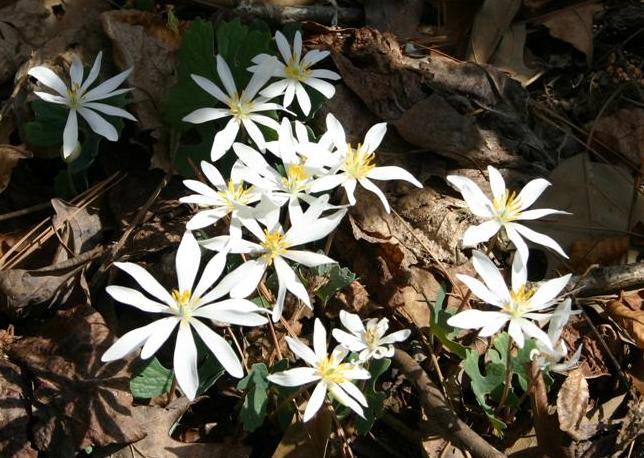
|
Need help?
Check out our Services.
We're also offering a 10% discount
for January appointments
|
|
Bloodroot in early March
|
Those who live in northern climates really have to reside themselves to the fact that when the waning warm days of
summer and fall are over, so are the blooms that accompany it. Not so in Georgia. With our temperate climate that can produce
temperatures in the 70s like we saw earlier this week, we have the luxury of being able to have flowers outside in every month of
the year.
Several factors can affect the color display of the fall and winter garden:
your location, winter temperatures and rainfall. Aberrations in weather
can catch the early bloomers off guard and ruin an otherwise colorful early
spring, as in mid March of 1993 when the “storm of the century” caused
a blizzard across northern Georgia. How sad it was to see singed Saucer
Magnolias and Forsythia afterwards. We have already seen some unusually
warm weather in 2009 and I saw at least one Okame Cherry and Loropetalum
in bloom this week.
The Plan
It is possible to have blooming plants in the garden from fall through winter until spring arrives in early April.
I can boast that I have something blooming in my garden every month of the year. Start by making a month-by-month list of blooming
plants and their requirements beginning with the late fall bloomers. Pay special attention to those that are fragrant
(marked with an asterisk *) and place them
where their aroma can be enjoyed such as near entrances, paths or walkways.
Fall to Early Winter (October - December)
Among the most reliable late fall bloomers are Camellia sasanquas and native
Witch Hazel* (Hamamelis virginiana).
Witch Hazel usually blooms in early to mid November in Atlanta. Camellia sasanquas usually begin blooming in October and will
continue (depending upon variety) through New Years. In my garden, Camellia sasanqua ‘Setsukegga’* starts in October and blooms for
nearly a month with yellow-centered white flowers. The aptly named ‘Yuletide’ Camellia blooms near Christmas with its bright red,
yellow-centered flowers. Early Camellia japonicas ‘White by the Gate’, ‘Christmas Beauty’, ‘High Hat’ and ‘Professor Sargent’
start their show in late November.
Perennial Gentians (Gentiana spp.) and Forsythia Sage (Salvia madrensis) will bloom until the first hard frost sends them into dormancy.
Finally, several bulbs including Autumn Crocus (Crocus speciosus) and hardy fall blooming Cyclamen (Cyclamen hederifolium)
round out the late fall season.

|
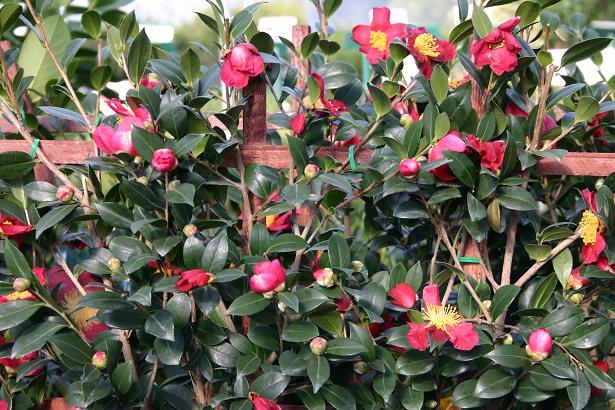
|
| Witch Hazel in November | Yuletide Camellia in December |
Early/Mid Winter Bloomers (January – February)
The timing and abundance of mid winter blooms can vary from year to year. In mild winters that were preceded by a good growing season, a
bountiful bouquet of flowers may be observed. In winters with harsh temperatures (teens or below) or that were preceded by a hot, dry
growing season, blooming plants may struggle. One plant that seems unfazed by cold temperatures is the Christmas Rose (Helleborus niger).
This shade tolerant evergreen perennial begins blooming in my garden in January and continues until March. Lenten Rose (Helleborus
orientalis) usually begins blooming in February and continues into early April.
January and February also mark the middle of the Camellia japonica blooming season. Midseason bloomers include ‘Mrs. Charles Cobb,’
‘Rebel Yell’ and ‘Clarise Carlton.’ I have observed that the open flowers of white-blooming camellias can turn brown in temperatures
below 25 degrees. Other shrubs blooming ar this time include Paper Plant (Edgeworthia spp.), Daphne* (Daphne odora), Wintersweet*
(Chimonanthes praecox), Vernal Witch Hazel* (Hamamelis vernalis) and hybrid Witch Hazels* (Hamamelis x intermedia).
Some of the earliest native ephemerals begin blooming at this time including Liverwort (Hepatica spp.) and Trout Lily
(Erythronium americanum). Reliable blooming bulbs are Snow Crocus (Crocus sieberi), Glory-of-the-snow
(Chionodoxa spp.), early Daffodils, Winter Aconite (Eranthis hyemalis), winter Cyclamen (Cyclamen coum) and
Snowdrops (Galanthus spp.).
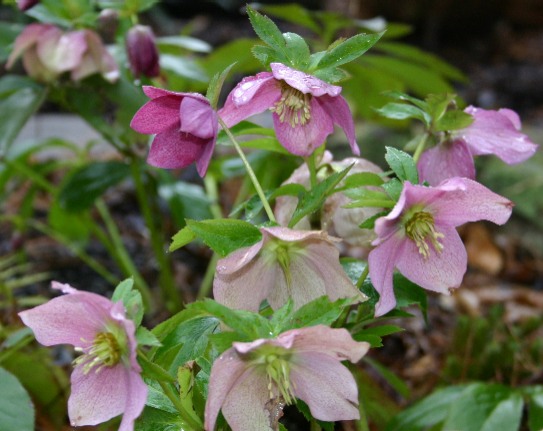
|
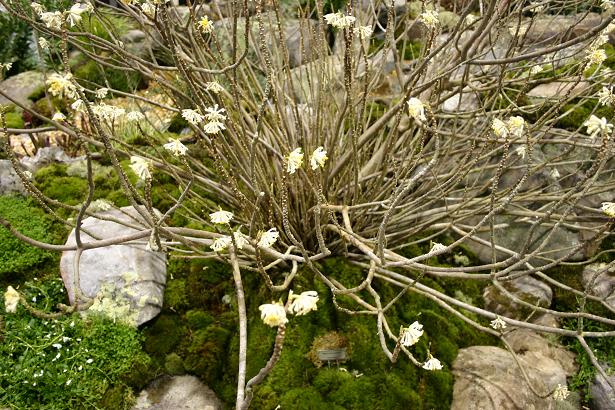
|
| Hellebores in January | Edgeworthia in January/February |
Late Winter Bloomers (March)
March is a peculiar month in Georgia. Sometimes it’s winter, sometimes it’s spring and usually it’s both, often in the same week. In recent
years, I have observed a familiar late winter weather pattern. Late February often ushers in a warm spell that continues into early March.
This false spring often encourages April bloomers to peak out early and then WHAM sometime around the third week of March we are hit with
a hard frost. In my opinion, plants that bloom in March have the toughest time of all dealing with such fluctuations in temperature.
The most familiar blooming trees in March are the Saucer Magnolia (Magnolia soulangiana), the foul-smelling Bradford Pear
(Pyrus calleryana 'Bradford') and the Redbud (Cercis canadensis). Other trees that can reach their peak prior to April 1
are the Okame Cherry (Prunus x incam 'Okame'), Serviceberry (Amelanchier spp.) and Red Maple (Acer rubrum). Every few years,
the Saucer Magnolia flowers get caught in a hard frost and are turned to a mushy brown. However, it appears to me that
those with darker purple blooms fair better in a frost then those with lighter pink flowers.
What would March in Georgia be without the Forsythia? Those bright yellow flowers are hard to miss. Other March blooming
shrubs include the late season Camellia japonica cultivars ‘Purity,’ ‘Dixie Knight’ and 'Lady Vansittart.’ Flowering Quince
(Chaenomeles japonica) often begins its show in very early March and Loropetalums (Loropetalum chinense) begin in mid March
and continue into early April.
March offers a few blooming vines like evergreen Clematis armandii* and Carolina Jessamine* (Gelsemium sempervirens).
Groundcovers like Georgia Blue Speedwell (Veronica peduncularis 'Georgia Blue') and Creeping Phlox (Phlox subulata)
can be covered in flowers well before April. The woodland natives Celandine Poppy (Stylophorum diphyllum), Rue Anemone
(Thalictrum thalictroides) and Bloodroot (Sanguinaria canadensis) light up the forest floor early in the month.
In my opinion, some of the best flowering bulbs reach their zenith before the official start of spring. These include early
Tulips, Spring Starflower (Ipheion uniflorum), Iris reticulata and Grape Hyacinths (Muscari botryoides).

|
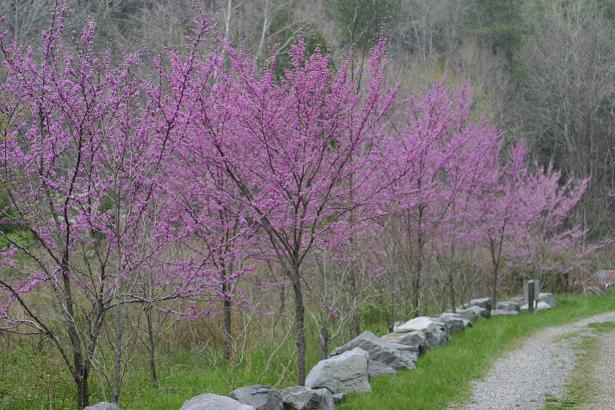
|
| Carolina Jessamine in early March | Redbuds in March |
Copyright © 2009 by Theresa Schrum - All rights reserved
No part of this website may be reproduced without the expressed written permission of Theresa Schrum







